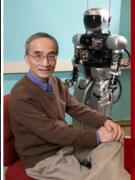


13:30-16:00 July 1st & 9:00-11:30 July 2nd
Mobile Robots for People with No Mobility
The Ohio State University
Biography
Professor Yuan F. Zheng ( 郑元芳 ) received his MS and Ph.D. degrees in Electrical Engineering from The Ohio State University (OSU) in Columbus, Ohio in 1980 and 1984, respectively. Professor Zheng’s undergraduate degree was received at Tsinghua University in Beijing, China in 1970. From 1984 to 1989, he was with the Department of Electrical and Computer Engineering at Clemson University in Clemson, South Carolina. While at Clemson University Professor Zheng invented the first Humanoid (Biped) Robot called CURBi in the U.S.A., and for which he received the Presidential Young Investigator Award from then President Ronald Reagan in 1986. Since August 1989, he has been with The Ohio State University, where Professor Zheng served as the Chairman of the Electrical and Computer Engineering Department between 1993 and 2004 and became Winbigler Designated Chair Professor thereafter. From 2004 to 2008, Professor Zheng served on a part-time basis as Dean of School of Electronic, Information, and Electrical Engineering at the Shanghai Jiao Tong University in Shanghai, China.
Professor Zheng was elected to IEEE Fellow in 1997, and has been active in serving IEEE and other technical communities, including IEEE Fellow Committee, Program Chairs of IEEE Conferences, and Vice President for Technical Affairs of the IEEE Robotics and Automation Society. Professor Zheng received numerous awards for his research contributions, including the Best Paper Award of the 2010 IEEE National Aerospace & Electronics Conference, the Fred I. Diamond Award for Best Technical Paper Published in a Referred Journal by the Air Force Research Laboratory in 2006, and Research Awards from the OSU College of Engineering three times. In 2016 Professor Zheng received the OSU Innovator of the Year Award for his invention of a new Speed Reducer for robots and precision machines.
Abstract
The number of people with no mobility grows much faster than ever before due to the broad use of automobiles which unfortunately induces accidents, while improved living conditions cause more stroke patients. The consequence is often the loss of mobility. The field of medical robotics has been investigating technologies which enable those people to walk again, instead of wheelchair-bound. In spite of ample efforts little success has been achieved due to a number of reasons. In this talk, the principles of human locomotion will first be reviewed. Various assistive technologies for the purpose will be presented, with the focus on exoskeleton robots. New promising technologies will be discussed with the audience.
